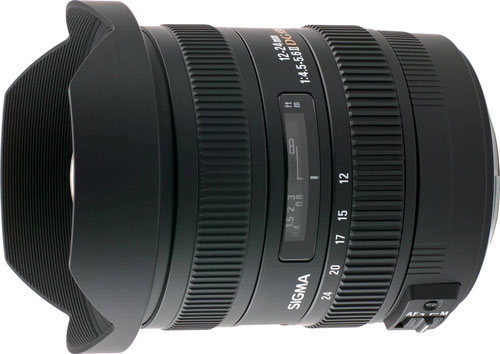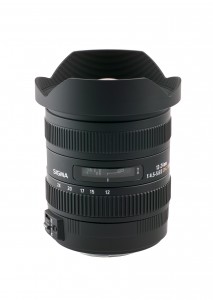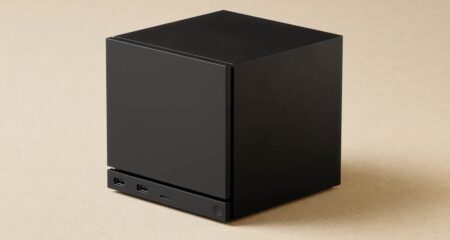
Japan’s Sigma makes its own cameras. But it’s far better known as a manufacturer of third-party lenses for more popular camera manufacturers such as Canon, Nikon, Sony and Pentax. Its new ultra-wide-angle lens, the Sigma 12-24mm 4.5-5.6 DG HSM, embodies the best of what the company has to offer, writes Craig Wilson.
For starters, the lens is compatible with full-frame digital cameras (where the sensor is the same size as a frame of 35mm film) as well as the more prolific cropped sensors, and available in Canon, Pentax, Sony and Nikon mounts. This means the lens can also be used on certain film bodies.
The lens includes different features depending on the mount. For example, Sigma’s HSM (its hypersonic autofocus system) only works on Canon and Nikon camera bodies, and the Canon has a physical switch to change between manual and autofocus while the Nikon does not. Similarly, the Pentax version of the lens includes an actual aperture ring — with an automatic setting — which none of the other models do. We reviewed the Nikon version of the lens.
Ultra-wide lenses are some of the most challenging to manufacture, and Sigma has done an admirable job of controlling both distortion and flare. There is no perceptible distortion at 12mm or 24mm, and although the lens is prone to lens flare, considering the front element is hemispheric, that’s entirely acceptable. Shooting into the sun is guaranteed to result in lens flare, but under normal conditions it’s unlikely to create a problem.
 Impressively, even at its widest apertures (f4.5 when at 12mm and f5.6 at 24mm), the Sigma exhibits no chromatic aberration (CA) at all. CA is coloured fringing that can appear around objects in high contrast situations such as tree branches backlit by the sun.
Impressively, even at its widest apertures (f4.5 when at 12mm and f5.6 at 24mm), the Sigma exhibits no chromatic aberration (CA) at all. CA is coloured fringing that can appear around objects in high contrast situations such as tree branches backlit by the sun.
The Sigma focuses internally, which means the front element doesn’t rotate. With many lenses this matters because it means that one can use filters like circular polarisers without having to make changes depending on focal length. As the Sigma cannot take filters, though, it simply means that the lens doesn’t protrude when zoomed.
Considering that the lens cap is 82mm, were the Sigma to take filters they’d be incredibly expensive anyway. In lieu of filters, the Sigma includes a holder on the rear of the lens that can take coloured gels.
The lens includes a depth-of-field scale, which is unfortunately omitted from many modern lenses and a welcome inclusion here. Being an ultra-wide, the minimum focusing distance is a mere 28cm and the depth of field is enormous, meaning it’s very difficult to get a glaringly out-of-focus shot.
The Nikon version of the lens includes both support for ultrasonic autofocus and the ability to manually adjust focus on the fly. It’s a great feature, and the sort that’s prized by professionals. “Professional” is perhaps the best description of the Sigma. It’s large, sturdy and, at 615g, makes a kit lens feel like a flimsy, plastic toy.
The maximum aperture of f4.5 at the wide end and f5.6 when zoomed isn’t particularly impressive but given the high ISO capabilities of modern cameras that doesn’t present much of an obstacle. Also, a faster aperture would mean an even larger front, larger glass elements, more weight and far higher price tag.
There is no in-lens image stabilisation available for the Sigma but being an ultra-wide it’s far less necessary than on longer lenses. In fact, it’s barely necessary at all. Pentax and Sony users still get image stabilisation via their cameras’ bodies, which aren’t lens dependent like Canon and Nikon.

Being a zoom lens, the Sigma isn’t quite as sharp as an ultra-wide prime lens (that is, a lens with a single focal length). But it still performs admirably in this department. Like most lenses, the Sigma performs at its best in the middle of its aperture range, between f8 and f11.
The Sigma is a great option for landscape or interior photographers who want a hardy ultra-wide with some zoom flexibility. It’s most impressive on a full-frame or film body, as on a cropped sensor like that of the Nokia D90 it’s the equivalent of an 18-36mm, which is still wide, but not quite ultra-wide, and arguably a waste of the lens’s superb capabilities.
The Sigma 12-24mm 4.5-5.6 DG HSM is available in Canon, Nikon, Pentax and Sony mounts for R9 299. — Craig Wilson, TechCentral
- Subscribe to our free daily newsletter
- Follow us on Twitter or on Facebook




